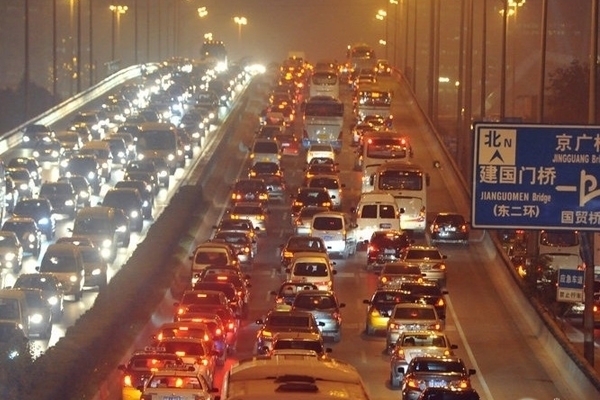


By Xie Liangbin (谢良兵), Lv Xiangrong (吕向荣) and Chen Zhe (陈哲)
Issue 636, Sept 9, 2013
Nation, page 14
Translated by Zhu Na
Original article: [Chinese]
On Sept 9, Beijing resident Zhang Ni (张霓) boarded a special bus that shuttles workers from her residential compound in Chaoyang District to their offices at the World Trade Centre downtown.
A spokesperson from the Publicity Department of Beijing Public Transport Holdings, Ltd. (BPT) told the Economic Observer that this bus shuttle service is aimed at people who own cars. It’s just one of the measures launched by the Beijing Municipal Commission of Transport to ease traffic congestion in September – the busiest month for traffic in the capital.
Traffic congestion has been growing at an unsustainable rate in Beijing, with the average commute time increasing from 38 minutes to 52 minutes from 2011 to 2012. The rapid growth in vehicle ownership is the main culprit for the increase. There are now 5.35 million cars in the city, so the major focus has become limiting this growth and getting existing car drivers to avoid driving to work during rush hour.
On Sept 4, Zhang Ni got her first taste of the paralyzing September traffic, which is especially bad due to the cool autumn weather, a new school semester and two national holidays. As soon as she drove her car out of her residential block, she was trapped in gridlock.
According to the municipal transportation authority, nine days this month are projected to be even worse. This forecast is based on a comparative analysis of traffic patterns during September over the past three years. Data shows that Beijing’s average daily congestion during this month is 46.1 percent higher than the annual average.
Zhang decided long ago that she didn’t like driving to work. In addition to the stress from the drive, her foot becomes sore from stepping on the brake so much. This is what many of Beijing’s private car owners are facing. The average annual mileage for a car in Beijing is 15,000 km - 1.5 times what it is in London and more than twice what it is in Tokyo.
However, since the subway and buses are so crowded during rush hour, Zhang chose to bear the drive rather than be “squeezed into a meat pie” (挤成“肉饼) on public transport. Even those who can bear the crowds would still usually rather drive. On average, a commute takes 2-to-2.5 times longer by public bus in Beijing than by car, due to the crowds and multiple transfers.
So Zhang was excited to learn that there would be a special business shuttle introduced. On Sept 1, the platform for booking the buses was officially launched by BPT with 62 busses on 31 routes. A round trip ticket costs 8 yuan if it’s within 20 km and 3 yuan extra for each additional 5 km. At just twice what it would cost to ride the subway, the guaranteed seat, Wi-Fi and air-conditioning make the busses a no-brainer for professionals like Zhang. She says the service has even cut the time she spends commuting to work from 60 minutes to about 35 minutes.
However, the business shuttle has yet to demonstrate any noticeable effect on traffic. Wang Jialiang (王家良), vice director of the BPT’s technology department, says that about 120 more shuttle buses are being prepared. Other measures to address the traffic include legalized carpooling, new bus lines, and building a unified information platform for booking taxis.
Ever since 2004, the Beijing Municipal Commission of Transport has been trying to ease traffic congestion. On Jan 1, 2011, the city began a lottery to limit the number of license plates issued each year. However, Guo Jifu (郭继孚), director of Beijing Transportation Development and Research Center, said that the benefits yielded by the restriction policy have been diminishing each year. “Compared to the rapid growth of cars, we haven’t kept pace in terms of infrastructure construction, public transportation, planning, management and other aspects,” Guo said.
In spite of tales of frustration with the overcrowding, Beijingers actually use public transport at a higher rate than any other Chinese city. In 2012, the proportion of residents using it in a given day reached 44 percent - a 2 percent increase over 2011.
During the “11th Five-Year Plan” (2006-2010), Beijing invested 250 billion yuan in the transportation system, accounting for 4.7 percent of the city’s total GDP. This was a 137.6 percent increase in spending over the “Tenth Five-Year Plan” period (2001-2005). However, the growth of Beijing’s population and car ownership has outpaced this expansion.
“Beijing’s traffic control will take time,” said Duan Liren (段里仁), former deputy head of the Beijing Transportation Administration.


